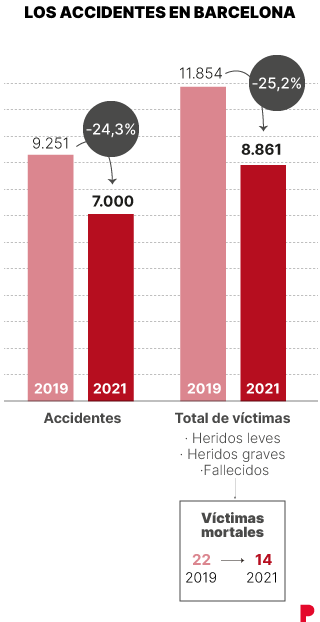-
The 12 planned in school settings and the four stretches are maintained, but the 32 at specific points will be, for now, only five
-
The rest of the planned speed controls will be placed, or not, depending on how habits change from next year
what should be a manual press conference Over the traffic accidents of the previous year has become a self amend of the Barcelona government to its own radar deployment plan inside the city. In March 2021, the former Councilor for Mobility, Rosa Alarconreported that the year would end with 32 radars installed in points of the city in which the speed is a major risk factor. This Tuesday, his successor in office, also socialist Laia Bonet, has reduced that figure to just five. And depending on how things go, we will see what happens with the rest. The 12 that will be placed in school settings and the four stretches in symbolic places such as the Rovira or Badal tunnels remain in the portfolio. All this happens, and it is not a minor thing, little more than a year for the elections.
The speed meters will begin to be installed in May. Those of point and those located in schools will have three phases. In September they will have a first educational stage in which drivers will be able to see the speed on a screen to which they circulate. Nothing more. In a second stage, from October to the end of December, offenders will receive a letter at home that will be merely informative. As of January 2023 there will no longer be a margin: sanction. In the case of section radars -in addition to those already exposed, those of Glòries and the Ronda Litoral– there is no possibility to indicate the speed in ‘displays’, so between May and the end of July, letters will be sent notifying, but not fining, speeding. In August, the wide sleeve ended. Thus, in January 32 radars will be operational: the 11 that are already they work in the accesses of the city, the 12 of the schools, the four of stretch and the five of point. We must add the mobile radars of the Urbana. Between them, in 2021 they imposed a total of 358,097 sanctions, almost a thousand a day.
Waiting
There are many, but the original plan called for a total of 59. The 27 that they lie fallow, Bonet has detailed, will be implemented “taking into account the effect that gradually produces” the placement of those that are planned. “We will put them or not depending on how habits change“. For the rest there is no calendar or guarantee that they will have a place in the city. Regarding the delay of the project -the initial idea was that they would be operational by the end of 2021-, the Councilor for Mobility has responded that it is due to a prolongation of the bidding process as a result of “a prior appeal”.
All this information has leaked in an unexpected way (by the press) in the presentation of the 2021 claims balancea year that still has a pandemic varnish which does not allow reaching conclusions about the moment Barcelona is going through in terms of road safety. The mobility was still weak in the first semester and recovered in the second, to the point that we are already in pre-pandemic levels. Between January and December there were 7,000 accidents with victims19 every day, 24.3% less than in 2019. 12 people lost their lives (11 men and one woman, eight of whom were motorcyclists) and 166 were seriously injured, 25.3% less than before the covid.
The Deputy Mayor for Security, Albert Batllehas placed the accent on the vulnerable groups, since 85% of the total serious injuries correspond to people who were on foot, by bike, on a scooter or on a motorcycle. Over the personal mobility vehicles (PMV)has recalled the municipal will of “put order in the new ways of getting around the city”. Of the 30 prevention campaigns launched last year, seven were for bikes and scooterssomething that the group of cyclists does not see with good eyes because they consider that they are being criminalized when the bulk of accidents They are caused by cars and motorcycles.

Related news
The sanction figures make clear the commitment of the government of Ada Colau in ordering the VMPs. In 2021, a total of 18,665 complaints were filed against private users of scooters (and the like), a 185.14% increase compared to 2019. The most persecuted, risky circulation (10,361 sanctions) or driving where it does not belong (sidewalks, basically, with 6,951 fines). As for bicycles, the increase was 82.4%, with a much more exhaustive control of cyclists that do not adopt the corresponding security measures (11,070 sanctions, almost 6,000 more than in 2019).
The cycling groups remember that the bulk of accidents motorcycles and cars are the protagonists and they regret that the Urbana allocates so much effort to “criminalize” them. The total number of vehicles involved, 68% are passenger cars and motorcycles, for 6m3 of bicycles and 5.7% of VMP. This last group, however, has experienced spectacular growth, since in 2019 they were only involved in 2.6% of claims. As for the causes, the lack of attention behind the wheel continues to grow. Perhaps a radar will help put all senses on the road. Maybe not.